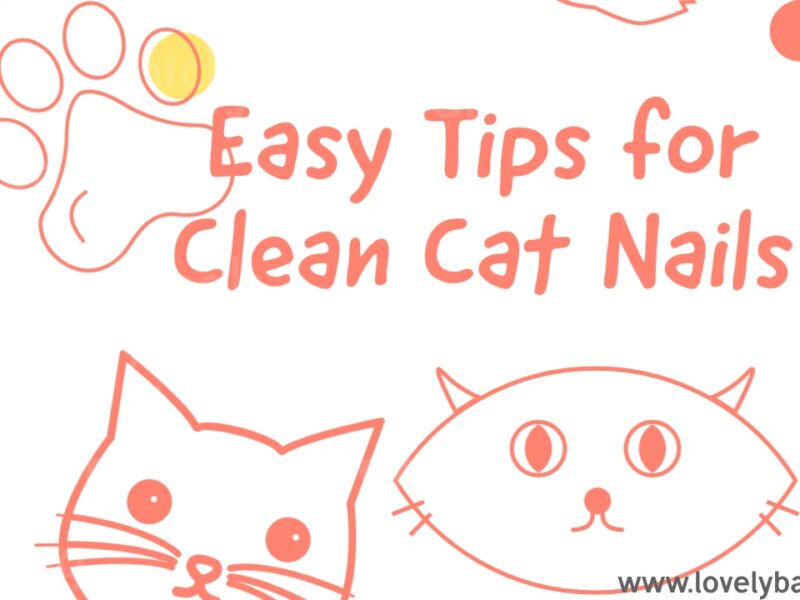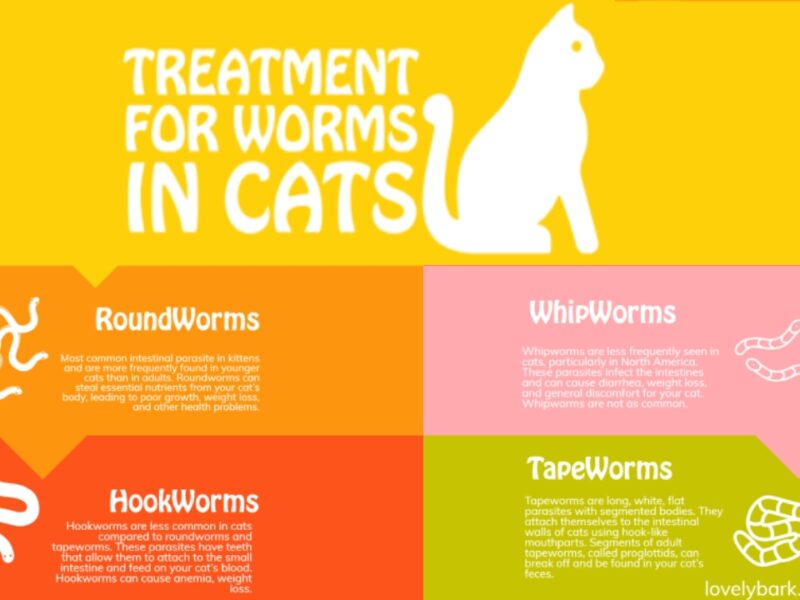Table of Contents
Tortoiseshell cats, also known as torties, are truly the mottled beauties of the feline world. With their unique coat pattern and vibrant colors, they never fail to catch the eye and captivate the heart. In this comprehensive guide, we will explore the fascinating facts and common questions surrounding these enchanting creatures. From their distinctive fur patterns to their spirited personalities, let’s dive into the captivating world of tortoiseshell cats.
What Makes a Tortoiseshell Cat?
Tortoiseshell cats, often referred to as torties, are not a specific breed but rather a coat pattern that can be found in various cat breeds. The name “tortoiseshell” comes from the resemblance of their fur pattern to the now-banned material made from the shells of tortoises and turtles. This unique pattern features a mixture of two or more colors, excluding white. While the most common combination is red and black, the “red” patches can also appear as orange, yellow, or cream, and the “black” can range from chocolate to grey or blue.
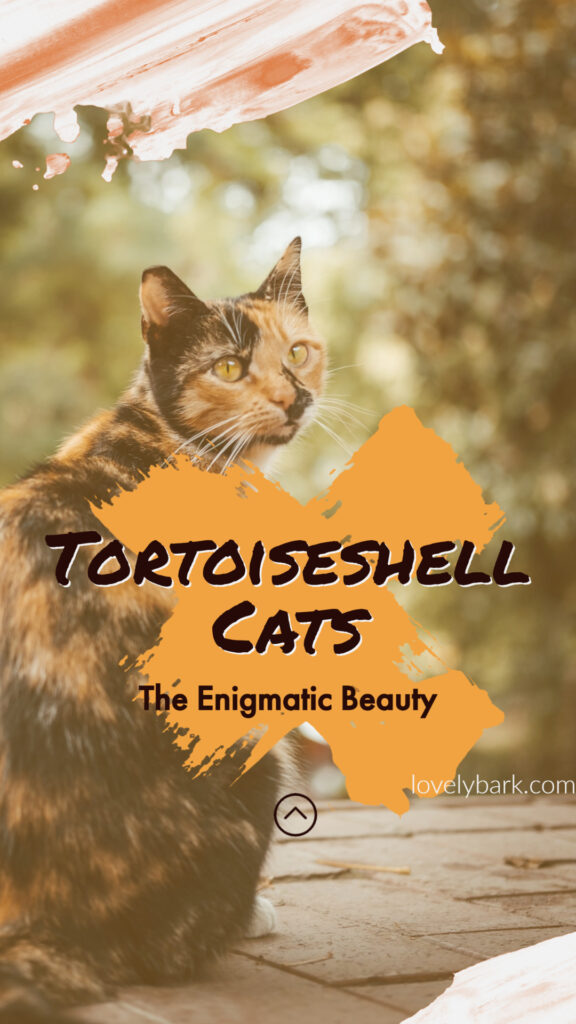
Tortoiseshell vs. Calico Cats
The terms “tortoiseshell” and “calico” are often used interchangeably, but they actually refer to different coat patterns. While both patterns involve a mixture of colors, the key distinction lies in the presence of white fur. Tortoiseshell cats have a combination of two or more colors without any white markings, whereas calico cats have a tri-color pattern consisting of white, black, and red or orange. So, if you come across a multi-colored cat with white in its fur pattern, it is more likely to be a calico rather than a tortoiseshell.
The Intricate Coat Patterns of Torties
The fur patterns of tortoiseshell cats can be further categorized into various sub-categories, each with its own unique characteristics. One such pattern is the “bridled” coat, in which the colors appear to be intricately woven together. This gives the cat’s fur a beautiful and complex appearance. Another variation is the “dilute tortoiseshell,” which results from recessive genes that create softer and lighter hues, such as cream, lilac, or cinnamon. These dilute torties exude a delicate and ethereal charm.
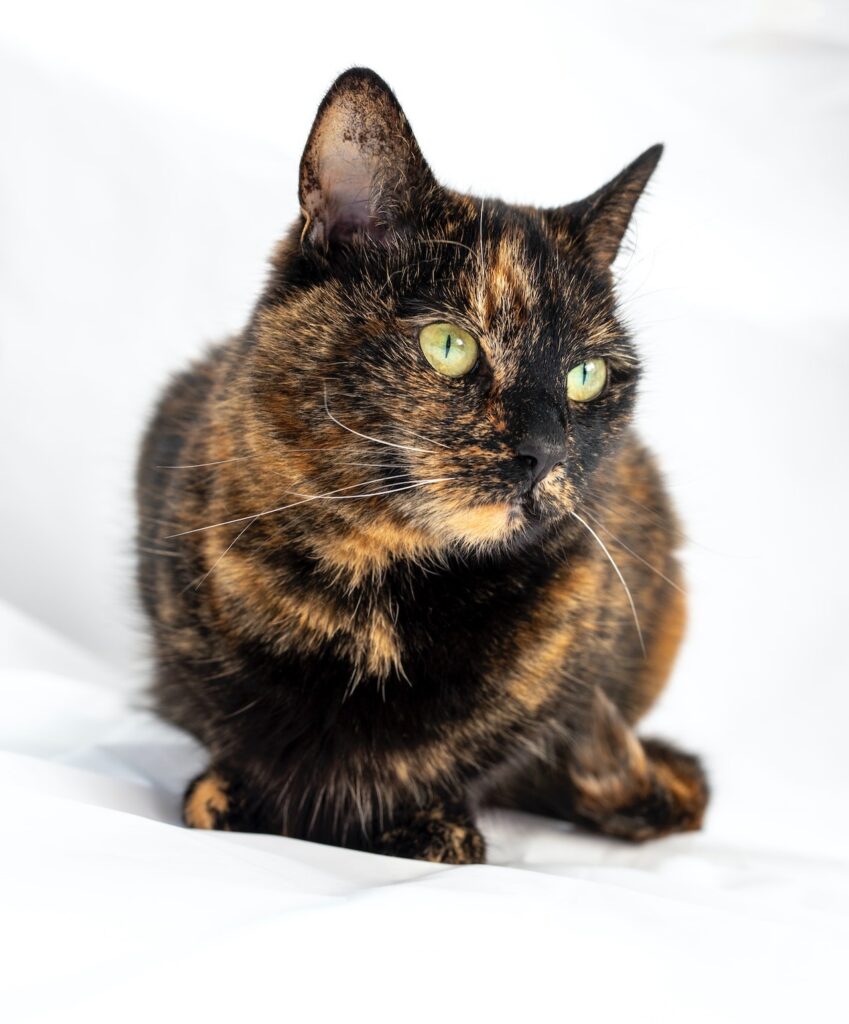
The Allure of Torbies
If you’re looking for even more visual interest, look no further than the “torbie” cats. Torbies are the delightful offspring of a tortoiseshell and a tabby cat. They exhibit patches of brown and orange tabby stripes, with the markings often more pronounced on their legs and head. Torbies combine the best of both worlds, showcasing the intricate patterns of tortoiseshell cats and the distinctive tabby markings.
The Rare and Mysterious Chimera Tortie
Among the various coat patterns, the rarest of them all is the chimera tortoiseshell. A chimera tortie is the result of two embryos merging in utero, forming one animal with two distinct colors on different sides of its body. This creates a truly remarkable and mesmerizing appearance. One famous example of a chimera tortie is Venus the Two Face Cat, who gained significant attention for her striking split face with different colors.
The Fascinating Genetics of Tortoiseshell Cats
The genetics behind tortoiseshell cats are quite intriguing. One of the most fascinating aspects is the overwhelming majority of torties being female. This is due to the fact that the tortoiseshell coat pattern is linked to the X sex chromosome. Female cats have two X chromosomes (XX), allowing for the expression of the tortoiseshell pattern. In contrast, male cats have one X chromosome and one Y chromosome (XY), which limits them to either black or orange fur. However, rare cases of male torties do exist, known as XXY Syndrome, but they are typically sterile and may suffer from health issues due to genetic abnormalities.
The Mythical Aura of Tortoiseshell Cats
Tortoiseshell cats have long been associated with myths and folklore, adding to their mystical allure. In Japan, they are believed to protect homes from ghosts, making them highly valued companions. In England, it is said that rubbing a tortoiseshell cat’s tail on a wart can cure it. The United States considers torties as “money cats,” believed to bring good fortune. In Southeast Asia, there is a belief that tortoiseshell cats originated from the blood of a young goddess. Ancient Celts regarded having a male tortoiseshell cat as a sign of good luck, and in Ireland, a tortie’s presence is seen as a fortunate omen.
Tortitude: The Mythical Personality of Tortoiseshell Cats
One aspect that often comes up in discussions about tortoiseshell cats is their alleged “tortitude.” Torties are known for their spirited and independent nature, often described as sassy and strong-willed. Many claim that they possess a unique personality and exhibit more sensitivity to their surroundings. However, scientific studies have not found a direct correlation between fur patterns and behavior. While the anecdotes and experiences of tortie owners suggest the existence of tortitude, it remains a topic of debate within the scientific community.
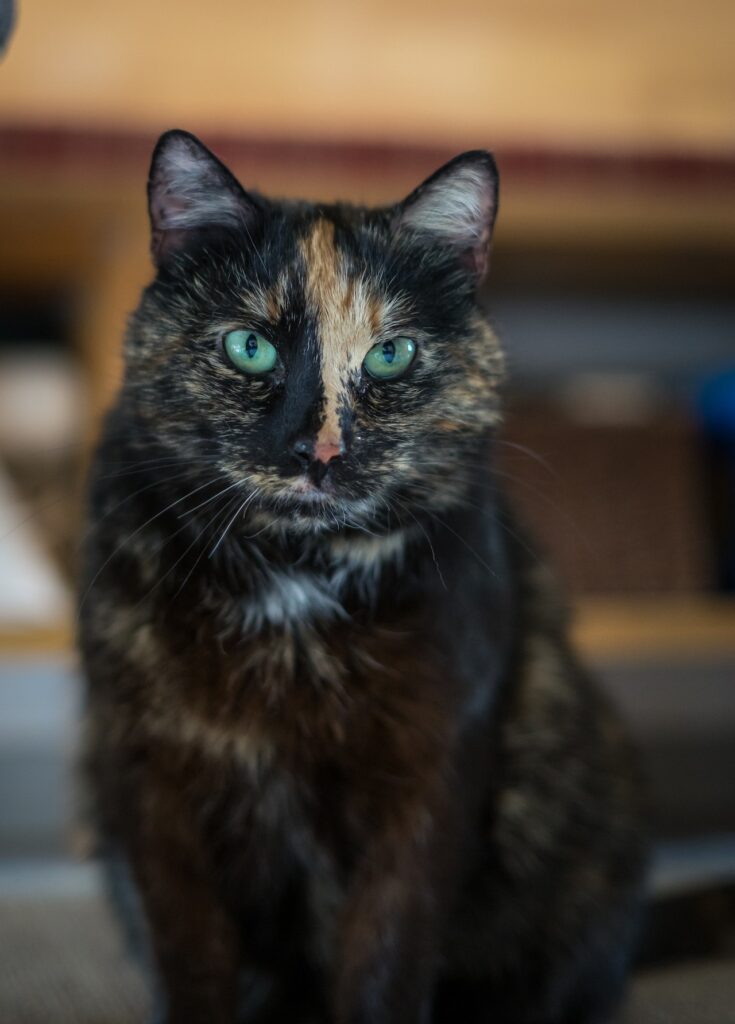
The Lifespan and Care of Tortoiseshell Cats
The lifespan of a tortoiseshell cat can vary depending on various factors, such as breed and overall health. In general, torties have the potential to live long and fulfilling lives, with some reaching the age of 20 or older. However, it is worth noting that male tortoiseshell cats tend to have shorter lifespans and may face additional health challenges due to their rarity and genetic abnormalities. Regular veterinary check-ups and proper care are vital to ensure the well-being of these remarkable feline companions.
Celebrating Tortoiseshell Cats Through History
Tortoiseshell cats have left their mark throughout history, captivating the hearts of notable figures and leaving a lasting legacy. One such admirer was the renowned author Edgar Allan Poe, who cherished his tortoiseshell cat named Cattarina. Even after Poe’s passing, the memory of Cattarina lived on and inspired future generations. Today, tortoiseshell cats continue to enchant and bring joy to countless individuals around the world, symbolizing luck, protection, and the innate beauty of nature.
Unique Beauty of Dilute Tortoiseshell Cats
Dilute tortoiseshell cats, also known as dilute torties, are a visually stunning and captivating feline breed. Their distinctive coat pattern and unique personality traits have made them increasingly popular among cat lovers. In this comprehensive guide, we will explore everything you need to know about dilute tortoiseshell cats, from their appearance and genetics to their care and health concerns.
What is a Dilute Tortoiseshell Cat?
A dilute tortoiseshell cat is a feline with a captivating coat pattern primarily composed of diluted shades of black, orange, and cream. The pattern, known as tortoiseshell, is created by the combination of two genes. One gene determines the black and orange colors, while the other gene controls whether the colors are diluted or not.
Unlike traditional tortoiseshell cats, dilute torties have softer, muted colors. Their coat can appear in shades of blue-gray, cream, and light peach. This diluted coloration is most commonly found in female cats, as the gene responsible for the coat pattern is carried on the X chromosome.
The Genetics Behind Dilute Tortoiseshell Coloring
To understand the genetics behind dilute tortoiseshell coloring, we need to delve into the complex world of cat genetics. Cats’ physical characteristics, including coat color, are determined by their genes, which are arranged in pairs. One pair of genes, known as sex chromosomes, determines the cat’s gender. Female cats have two X sex chromosomes, while male cats have one X and one Y sex chromosome.
In tortoiseshell cats, the X chromosome contains instructions for both orange and black fur. During the earliest development of an unborn kitten, one X chromosome in each cell deactivates through a process called lyonization. This deactivation is random, resulting in some skin cells retaining the instruction for orange fur and others for black fur. Consequently, a tortoiseshell pattern emerges.
Adding the “Dilute” to Dilute Tortoiseshell Cats
The dilution of the tortoiseshell pattern is influenced by genetics and results in the pastel colors that make dilute torties so appealing. These colors are actually diluted versions of black and red pigmentation. When black pigment is diluted, it turns into a blue shade, while red pigment becomes cream, similar to adding white paint to black or red paint.
The dilution of these pigments occurs due to a specific mutation in a gene called the melanophilin gene, also known as the MLPH gene. This gene plays a vital role in the pigment-producing cells that give cats’ coats their color. When the MLPH gene is mutated, it doesn’t function correctly, resulting in decreased pigment production. As a result, the hairs that grow from these cells have a diluted appearance. This mutation is recessive, meaning a dilute tortoiseshell cat needs to inherit it from both parents for it to show in their coat.

Are Dilute Tortoiseshell Cats Rare?
Dilute tortoiseshell cats can be considered relatively rare due to the statistical odds of their appearance. To have a tortoiseshell pattern, a cat needs two X chromosomes, which means they must be female. This alone rules out half of the cat population. Additionally, female tortoiseshell cats must carry two recessive genes for dilution.
However, despite these odds, dilute tortoiseshell cats are more common than one might think. The tortoiseshell coloring can appear in many cat breeds, which means there are more dilute tortoiseshell cats out there than the genetic odds alone would suggest. From classic domestic shorthairs to fancier breeds like Persians or Scottish Folds, dilute torties can be found in all shapes and sizes.
The Interesting Case of Male Dilute Tortoiseshell Cats
One fascinating aspect of dilute tortoiseshell cats is that they are almost exclusively female. This is due to the genetics behind the tortoiseshell pattern. Male cats typically have the XY combination of sex chromosomes, with only one X chromosome. As a result, they have only one instruction for coat color, ruling out the possibility of tortoiseshell patterning.
However, there are exceedingly rare cases where male cats are born with two X chromosomes and a Y chromosome (XXY). This condition, known as Klinefelter syndrome, can result in male cats expressing tortoiseshell and dilute tortoiseshell coloring. These cats are often infertile but serve as fascinating examples for genetics classes and enthusiasts.
Dilute Tortoiseshell Cats: Personality and Temperament
In addition to their captivating appearance, dilute tortoiseshell cats are known for their unique personality traits. These cats are often described as fiercely independent, strong-willed, and feisty. They possess a high level of energy and express themselves through vocalizations and body language.
While some tortie owners report that their cats have a distinct “tortitude,” or tortie attitude, the correlation between coat color and behavior has not been definitively proven. Studies examining links between coat color and increased aggression have yielded inconclusive results. Therefore, it’s important to remember that each cat, including dilute torties, has an individual personality that may or may not align with generalizations.
Caring for Dilute Tortoiseshell Cats
Caring for a dilute tortoiseshell cat involves providing them with the same level of care and attention as any other feline companion. Regular grooming is essential to prevent matting and the formation of hairballs. Dilute torties, like other cats, benefit from regular nail trimming and dental care to maintain their overall health.
A well-balanced diet of high-quality cat food, with an emphasis on protein and essential nutrients, is crucial for the health and vitality of dilute tortoiseshell cats. Fresh water should always be available, and a clean litter box should be provided.
Dilute torties are energetic and playful cats, so it’s important to provide them with plenty of opportunities for exercise and mental stimulation. Interactive toys and scratching posts can help keep them entertained and prevent boredom or destructive behavior.
Creating a safe and comfortable living environment is also important for dilute torties. They enjoy having a designated space to call their own, such as a cozy cat bed or a window perch where they can observe the world around them.
Health Concerns for Dilute Tortoiseshell Cats
While dilute tortoiseshell cats are generally healthy and robust, there are a few health concerns that owners should be aware of. These cats may be more prone to urinary tract infections, bladder stones, kidney disease, obesity, and dental problems. Regular veterinary check-ups and prompt attention to any unusual behavior or symptoms are essential for maintaining their well-being.
Adopting a Dilute Tortoiseshell Cat
If you’re considering adopting a dilute tortoiseshell cat, there are several options available. Many animal shelters and rescue organizations have a variety of cats, including dilute torties, looking for loving homes. Before adopting, it’s important to consider the time and financial commitment involved in caring for a cat.
When adopting a dilute tortoiseshell cat, take the time to get to know their personality and behavior. Each cat has a unique history and may require time to adjust to a new home and family.
Conclusion
In general, tortoiseshell cats are truly extraordinary creatures, with their unique coat patterns and captivating personalities. Whether you’re drawn to their enigmatic beauty or fascinated by their mythical aura, torties have a way of leaving a lasting impression. From their intricate fur patterns to their spirited attitudes, these feline wonders continue to captivate cat lovers worldwide. So, the next time you encounter a tortoiseshell cat, take a moment to appreciate their remarkable presence and celebrate their timeless charm.
Read more cat blog stories.
”FAQs”
Are tortoiseshell cats all female?
Almost all tortoiseshell cats are females. This is because females have two X chromosomes, and it's this chromosome that carries the genetic information for black or orange coat colour.
Are tortoiseshell cats very friendly?
Tortoiseshell cats are beautiful creatures affectionally called torties. Best known as the divas of the cat world, this particular kind of cat hides surprising facts within its unique multicolor fur. Although they are recognized for being sassy, vocal felines, they also love their owners with fierce loyalty.
Is tortoiseshell cat rare?
Torties aren't a specific breed; they are a mixed-breed, American shorthair. How rare is a tortoiseshell cat? Tortoiseshell cats are not rare, and you can find them through shelters, fosters, and rescue groups. What is rare is a male tortoiseshell, about one in 3,000!
Why are tortoiseshell cats special?
Tortoiseshell cats are sometimes credited with having a strong-willed and hot-tempered personality. Cat aficionados believe these feisty personality traits are linked to the unique pattern of the cat's fur coat. Folklore also attributes the "torties" with bringing their owners luck.

